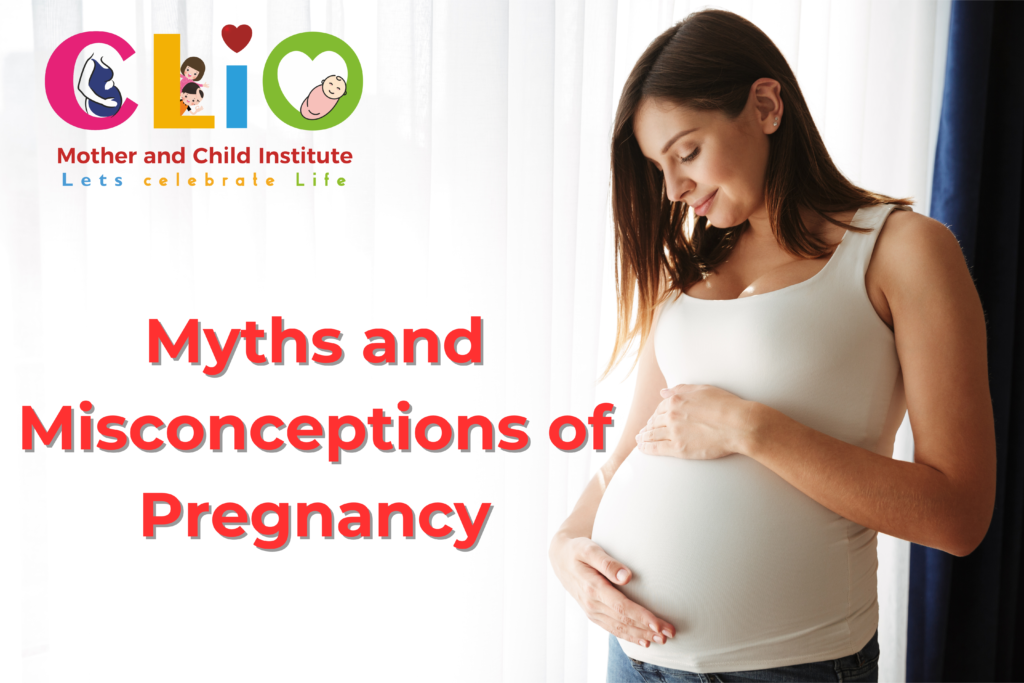Introduction
Pregnancy is a miraculous and transformative journey, often accompanied by a flood of advice, old wives’ tales, and age-old myths that have been passed down through generations. In the age of information, it is crucial to distinguish between well-founded knowledge and the myths and misconceptions that persist. In this blog, we’ll debunk some common myths surrounding pregnancy, empowering expectant mothers with accurate information and allowing them to navigate this incredible experience with confidence.
10 Myths and Misconceptions of Pregnancy
Myth #1: Eating for Two
One of the most pervasive myths about pregnancy is the idea that expectant mothers should “eat for two.” While it’s true that a pregnant woman’s nutritional needs increase, it doesn’t mean doubling the caloric intake. Quality over quantity is key. A well-balanced diet rich in nutrients is more beneficial than overeating, as excessive weight gain can lead to complications.
Myth #2: The Shape of Your Belly Determines Baby’s Gender
The belief that the shape of your belly can predict the gender of the baby is simply a myth. The way your belly looks is influenced by various factors, including your body shape, muscle tone, and the position of the baby. The only accurate ways to determine the baby’s gender are through medical tests like ultrasound or genetic screenings.
Myth #3: Avoid Exercise to Prevent Harm to the Baby
Exercise during pregnancy is not only safe but also beneficial for both the mother and the baby. Of course, certain high-risk activities should be avoided, but moderate exercise can help reduce the risk of complications, improve mood, and contribute to overall well-being.
Myth #4: Heartburn Means Your Baby Will Have a Lot of Hair
There’s a common belief that experiencing heartburn during pregnancy is a sign that your baby will be born with a full head of hair. However, scientific studies have not established a clear connection between heartburn and a hairy baby. Heartburn is more likely due to hormonal changes relaxing the valve between your esophagus and stomach.
Myth #5: Morning Sickness Only Happens in the Morning
Morning sickness is not just a morning sickness; it may occur at any time of day or night. Some women may feel uncomfortable all day, while others may only have nausea and vomiting in the morning. Everybody experiences morning sickness differently, both in terms of intensity and timing.
Myth #6: Cocoa Butter Prevents Stretch Marks
While keeping the skin moisturized is essential for comfort, there’s no conclusive evidence that cocoa butter or any other cream can prevent stretch marks. Genetics, weight gain, and skin elasticity play significant roles in determining whether stretch marks will occur. Staying hydrated and maintaining a healthy weight can contribute to skin health.
Myth #7: The Shape of Your Navel Determines Belly Button Popping Out
The idea that the shape of your navel before pregnancy can predict whether it will pop out or stay in is unfounded. Belly button changes during pregnancy are primarily influenced by the stretching of the abdominal wall and the position of the baby, not the pre-existing shape of the navel.
Myth #8: The Way You Carry Determines the Gender
Another gender-related myth is that the way a woman carries her baby can indicate its gender. However, the way the baby is positioned is more influenced by factors like the mother’s muscle tone, body shape, and the number of pregnancies, rather than the baby’s gender.
Myth #9: You Can’t Dye Your Hair During Pregnancy
There’s a common misconception that dyeing your hair during pregnancy can harm the baby. However, most studies have shown that the small amount of chemicals absorbed through the skin during hair dyeing is unlikely to pose a risk. Still, it’s advisable to use hair dyes with caution, especially in the first trimester, and to ensure good ventilation during the process.
Myth #10: You Shouldn’t Travel During Pregnancy
While it’s true that certain complications may limit travel during pregnancy, the general notion that pregnant women should avoid travel altogether is a myth. Most healthy pregnant women can safely travel until the later stages of pregnancy. It’s crucial to consult with a healthcare provider before making any travel plans, especially if there are underlying health concerns.
Conclusion
Pregnancy is a unique and individual experience for every woman, and separating fact from fiction is crucial for a healthy and informed journey. Myths and misconceptions can add unnecessary stress and anxiety to an already transformative time. By debunking these common myths, expectant mothers can approach their pregnancy with confidence, armed with accurate information that empowers them to make informed decisions for themselves and their growing families. As always, consulting with healthcare professionals for personalized advice is key to a healthy and happy pregnancy.


